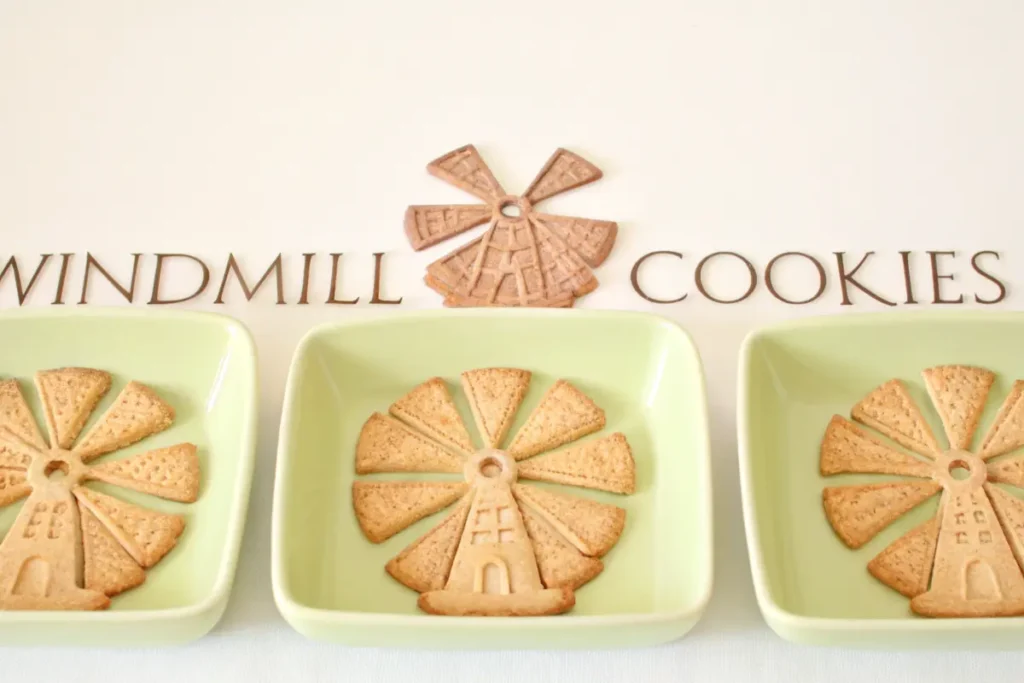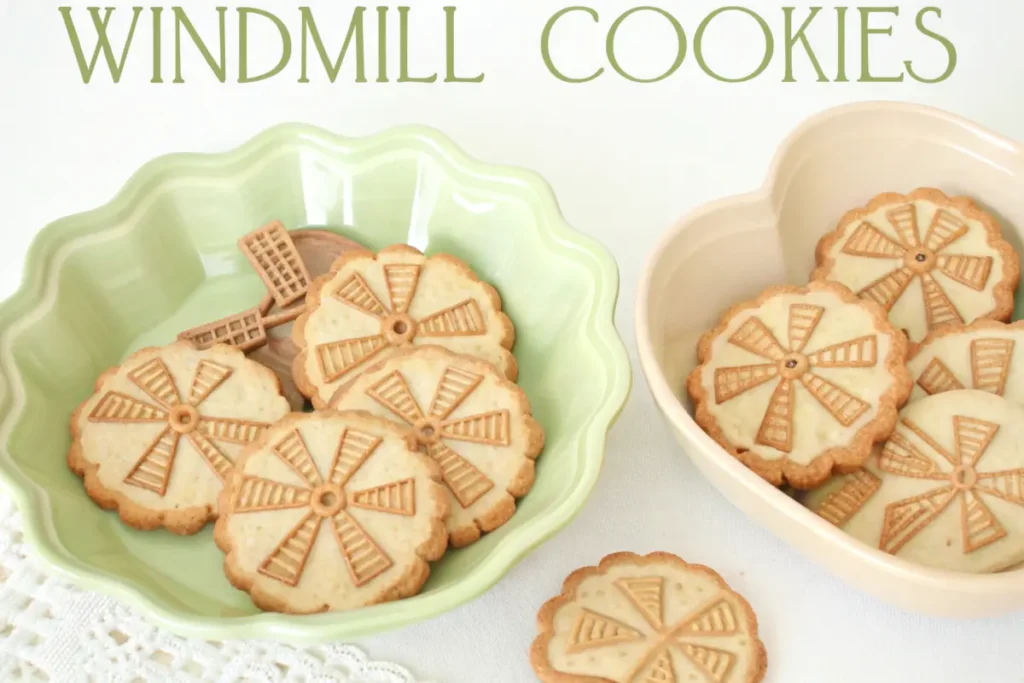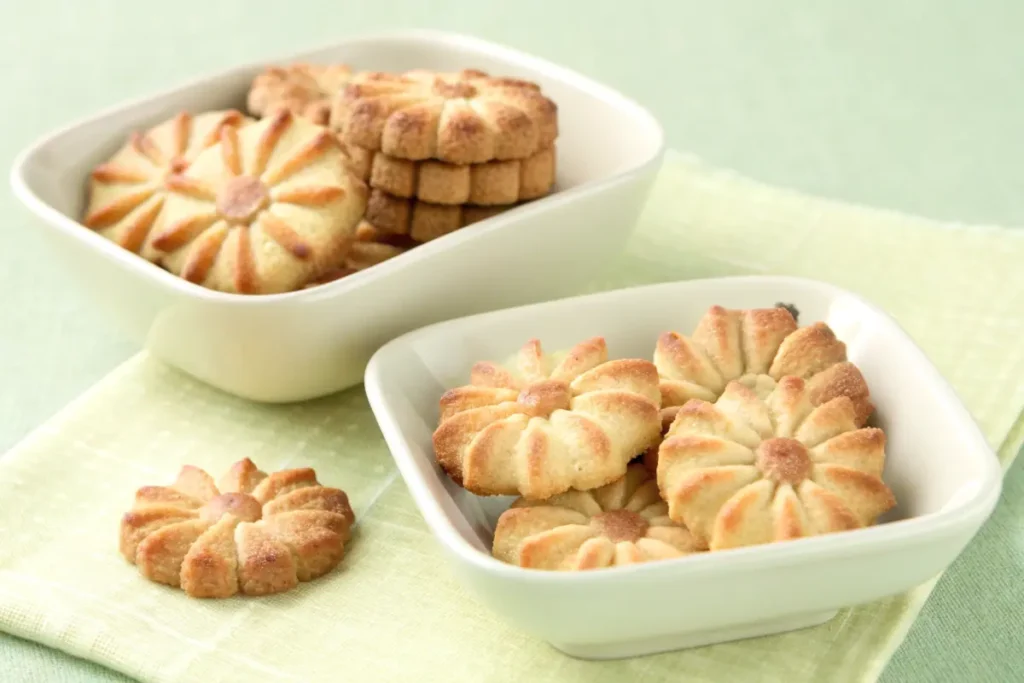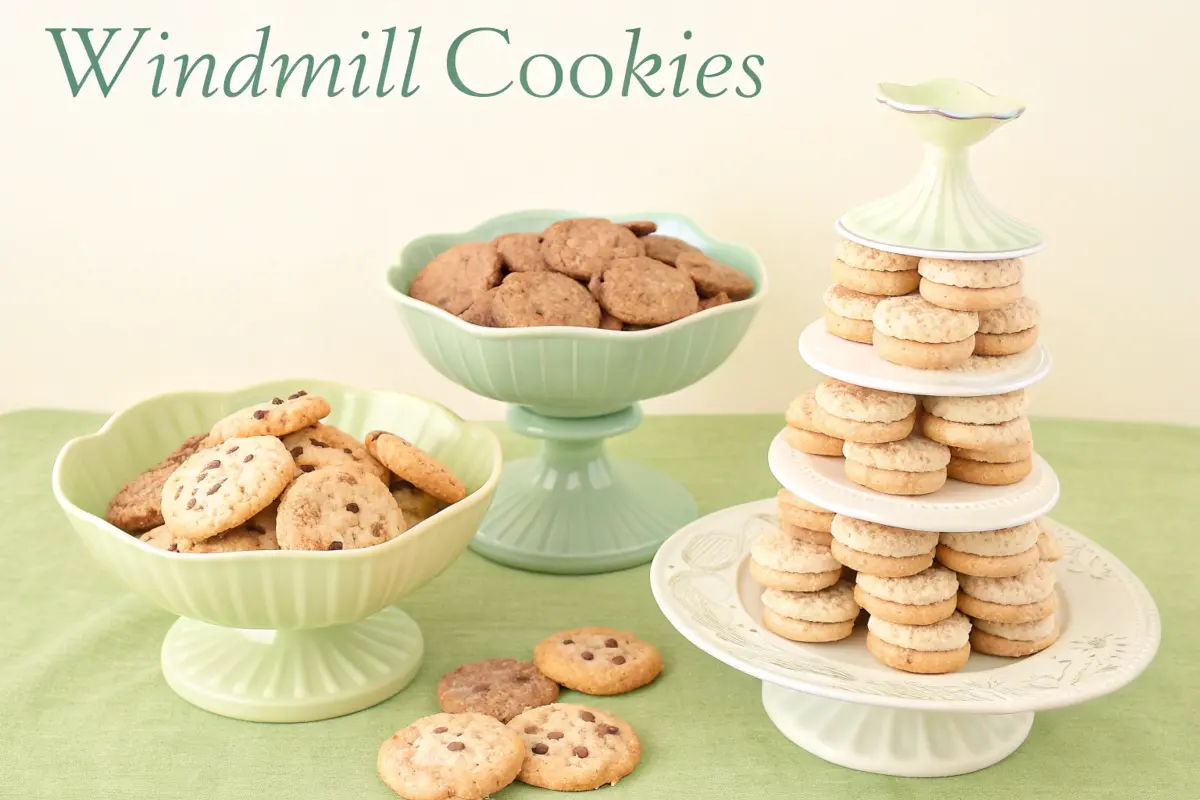Windmill cookies are a timeless treat that evoke nostalgia with every bite. Their distinctively spiced flavor and intricate designs make them both a feast for the taste buds and the eyes. But what are windmill cookies, and why do they hold such a special place in the hearts of many? In this article, we’ll explore their origins, ingredients, cultural significance, and why they remain so popular.
What Are Windmill Cookies?
They are often known as speculaas or speculoos, are traditional spiced cookies originating from the Netherlands and Belgium. They are famous for their crunchy texture, aromatic spices, and characteristic windmill imprint. These cookies are especially popular during the holiday season but are enjoyed year-round due to their irresistible flavor.
Key Characteristics of Windmill Cookies:
- Distinct Design: The iconic windmill shape and patterns are usually created with special molds or stamps.
- Flavor Profile: A rich blend of spices, including cinnamon, nutmeg, cloves, and ginger.
- Texture: Delightfully crisp with a melt-in-your-mouth quality.
Their Historical Roots
The history of windmill cookies dates back to the 17th century when Dutch bakers perfected the art of making speculaas. The term speculaas is thought to derive from the Latin word speculum, meaning mirror, referring to the mirrored designs on the cookies. These designs were originally carved into wooden molds, showcasing intricate patterns such as windmills, St. Nicholas figures, and Dutch landscapes.
They were traditionally baked to celebrate St. Nicholas Day on December 5th. Over time, they became a staple treat in Dutch households and eventually spread to other parts of Europe and the United States.
Ingredients That Define the Flavor
The signature flavor of windmill cookies comes from a harmonious blend of spices and natural ingredients. Let’s break down what makes these cookies so special:
1. Spices
The spice mix, known as speculaaskruiden, is the heart of windmill cookies. It typically includes:
- Cinnamon
- Nutmeg
- Cloves
- Cardamom
- Aniseed
2. Almonds
Many traditional recipes incorporate slivered almonds, either as a topping or mixed into the dough, adding a subtle nuttiness.
3. Molasses or Brown Sugar
These ingredients give windmill cookies their characteristic golden-brown color and a deep, caramel-like sweetness.
4. Flour and Butter
The base of the cookie is typically made with all-purpose flour and butter, creating a rich and crumbly texture.
The Cultural Significance of Windmill Cookies

They hold a cherished place in both Dutch and Belgian culture, symbolizing tradition, warmth, and celebration. They are often exchanged as gifts, enjoyed with coffee or tea, and served at festive gatherings. In the United States, they gained popularity in the mid-20th century when brands like Steenstra’s introduced mass-produced versions.
Modern-Day Popularity
Today, windmill cookies are celebrated worldwide. Their unique flavor and artistry make them a favorite among cookie enthusiasts and home bakers. Many modern versions have adapted the recipe to include gluten-free or vegan options, catering to diverse dietary needs.
Why Windmill Cookies Are So Popular
These cookies have stood the test of time for a variety of reasons:
- Nostalgia: Their association with childhood memories and family traditions.
- Flavor: The perfect balance of sweet, spicy, and nutty notes.
- Aesthetic Appeal: Their intricate designs make them almost too beautiful to eat.
How to Enjoy them
Windmill cookies are versatile, making them a delightful addition to any occasion. Here are some of the most popular ways to enjoy them:
1. Paired with Beverages
Windmill cookies are often served alongside hot drinks, as their spiced flavor complements beverages perfectly:
- Coffee: The bold spices of windmill cookies enhance the richness of a fresh cup of coffee.
- Tea: Pair them with chai, black tea, or even herbal blends for a comforting treat.
- Hot Chocolate: The sweetness and creaminess of hot chocolate create a delightful contrast.
2. As a Dessert Component
Incorporate windmill cookies into your favorite desserts:
- Cheesecake Base: Use crushed windmill cookies as a substitute for graham crackers in cheesecake crusts.
- Ice Cream Topping: Crumble cookies over vanilla or caramel ice cream for a crunchy, spiced topping.
- Cookie Butter: Blend windmill cookies into a creamy spread that can be enjoyed on toast or used as a dip.
3. Festive Gifting
Windmill cookie makes an excellent gift during the holiday season. Wrap it in decorative tins or boxes for a thoughtful and delicious present.

Health Benefits of Windmill Cookies
While they are undeniably a treat, they also offer some surprising health benefits thanks to their spice-rich profile. Let’s explore why these cookies can be a more wholesome indulgence compared to other sweets.
1. Rich in Antioxidants
The spices used in windmill cookies, such as cinnamon and cloves, are packed with antioxidants that help combat oxidative stress in the body.
2. Digestive Benefits
- Ginger: Often included in the spice mix, ginger supports healthy digestion and can help alleviate nausea.
- Cloves and Cardamom: Known for their digestive properties, these spices may reduce bloating and improve gut health.
3. Lower Sugar Variations
Modern recipes often use natural sweeteners like honey or maple syrup, reducing the refined sugar content while maintaining flavor.
Creative Recipes Featuring Windmill Cookies
If you’re looking to go beyond the classic version, here are some creative recipes that showcase the versatility of windmill cookies:
1. Windmill Cookie Tiramisu
Give the Italian classic a Dutch twist by layering mascarpone cheese, coffee-soaked windmill cookies, and cocoa powder. This dessert offers a unique blend of creamy and spiced flavors.
2. Speculaas Truffles
Turn crushed windmill cookies into bite-sized truffles:
- Mix cookie crumbs with cream cheese and almond extract.
- Roll into balls and coat with melted chocolate or cocoa powder.
- Chill until firm and enjoy as a decadent treat.
3. No-Bake Windmill Cookie Bars
Create a quick and easy dessert using just a few ingredients:
- Combine crushed windmill cookies with melted butter and press into a baking dish.
- Layer with whipped cream, caramel, or chocolate ganache.
- Refrigerate until set and slice into bars.
Each of these recipes highlights the versatility of them and their ability to elevate desserts into something extraordinary. For more inspiration, consider checking out our recipe for Nestle Chocolate Chip Cookies or learn how these cookies can pair beautifully with a drink like Jamaican Blue Mountain Coffee.

Windmill Cookie Around the World
Although windmill cookies have Dutch origins, variations can be found in different cultures. Let’s explore how similar cookies are enjoyed globally:
1. Belgium
Known as speculoos, these cookies are slightly sweeter and often used to make cookie butter. Brands like Lotus have popularized this version internationally.
2. Germany
In Germany, a similar spiced cookie called lebkuchen is a holiday staple. While not shaped like windmills, these cookies share a comparable spice profile.
3. Scandinavia
In Sweden and Norway, spiced cookies such as pepparkakor resemble windmill cookies in both flavor and texture.
4. United States
Windmill cookies gained a foothold in the U.S. thanks to Dutch immigrants. Brands like Steenstra’s and Archway offer widely loved versions of this classic treat.
Sustainability and Windmill Cookies
In today’s environmentally conscious world, their production is also embracing sustainability. Many companies are:
- Using Organic Ingredients: Sourcing spices and almonds from sustainable farms.
- Reducing Packaging Waste: Offering eco-friendly packaging options.
- Promoting Local Bakeries: Encouraging the purchase of handmade cookies from local artisans.
By supporting brands that prioritize sustainability, you can enjoy them while contributing to a better planet.
The Enduring Legacy of Windmill Cookies
The timeless appeal of windmill cookies lies in their unique combination of artistry, flavor, and tradition. Whether you enjoy them with a cup of coffee, use them as a dessert ingredient, or share them as gifts, these cookies continue to bring joy across generations.
How to Make Authentic Windmill Cookies at Home
Baking them at home is a rewarding experience, allowing you to customize their flavor and design while filling your kitchen with the irresistible aroma of spices. Follow this step-by-step guide to craft your own batch of these iconic cookies.
Ingredients:
- 2 cups all-purpose flour
- 1/2 cup almond flour (optional for added nuttiness)
- 1/2 teaspoon baking soda
- 1 teaspoon ground cinnamon
- 1/2 teaspoon ground nutmeg
- 1/2 teaspoon ground cloves
- 1/4 teaspoon ground ginger
- 1/2 teaspoon salt
- 1/2 cup unsalted butter, softened
- 3/4 cup brown sugar
- 1/4 cup molasses
- 1 large egg
- 1 teaspoon almond extract
- Sliced almonds for decoration (optional)
Instructions:
- Prepare the Dough:
- In a mixing bowl, whisk together the all-purpose flour, almond flour, baking soda, spices, and salt.
- In a separate bowl, cream the butter and brown sugar until light and fluffy.
- Add the molasses, egg, and almond extract to the butter mixture and beat until combined.
- Combine Ingredients:
- Gradually add the dry ingredients to the wet mixture, stirring until a dough forms.
- Shape the dough into a ball, wrap it in plastic wrap, and chill for at least 1 hour.
- Roll and Cut:
- Preheat your oven to 350°F (175°C).
- Roll out the chilled dough on a floured surface to about 1/4 inch thickness.
- Use windmill-shaped cookie cutters or molds to cut out cookies.
- Decorate:
- Press sliced almonds onto the cookies for added texture and visual appeal.
- Bake:
- Place the cookies on a parchment-lined baking sheet.
- Bake for 10-12 minutes or until the edges are golden brown.
- Allow the cookies to cool completely before serving.
Tips for Perfect Windmill Cookies
Baking windmill cookies can be a fun and creative process, but achieving perfection requires attention to detail. Here are some tips to ensure your cookies turn out beautifully every time:
1. Master the Dough Consistency
- If your dough is too sticky, add a small amount of flour while rolling.
- Over-chilling the dough can make it hard to roll; let it sit at room temperature for a few minutes before working with it.
2. Achieve Crispness
- For a crunchier texture, bake the cookies a few minutes longer, keeping a close eye on the edges.
3. Use Quality Spices
- Freshly ground spices yield the best flavor. Consider grinding your own cinnamon or cloves for a more aromatic result.
4. Invest in Molds
- To create intricate designs, use traditional wooden molds or high-quality silicone molds.
The Nostalgia of Windmill Cookies
They have an unparalleled ability to evoke cherished memories. For many, these cookies are synonymous with family gatherings, holiday traditions, and cozy afternoons. Let’s explore why they continue to hold such sentimental value.
1. A Connection to Heritage
- For Dutch and Belgian families, windmill cookies are a link to cultural roots, often passed down through generations.
2. A Symbol of Celebration
- Traditionally enjoyed during St. Nicholas Day, these cookies represent joy and festivity.
3. Childhood Memories
- For many who grew up in the U.S., mass-produced versions of windmill cookies from brands like Archway were a lunchbox staple.
Why Windmill Cookies Stand the Test of Time
In an era where trends come and go, they remain a constant. Here’s why their appeal endures:
1. Timeless Design
- The intricate windmill shape and patterns are a hallmark of craftsmanship.
2. Versatility
- Whether enjoyed plain, dipped in chocolate, or incorporated into desserts, their versatility keeps them relevant.
3. Universal Flavor
- The warm, spiced profile appeals to diverse palates and pairs well with modern flavors.
Fun Facts About Windmill Cookies
- Speculaas Day: In the Netherlands, December 5th is unofficially dubbed “Speculaas Day,” marking the height of their popularity during St. Nicholas celebrations.
- Origins of the Windmill Design: The windmill imprint pays homage to Dutch landscapes and is a symbol of the country’s innovation.
- World’s Largest Speculaas: A record-breaking windmill cookie was baked in 2009 in the Netherlands, weighing over 125 pounds!
- National Cookie Day: In the U.S., windmill cookies are often celebrated during National Cookie Day on December 4th.
- Speculaas Spread: Lotus Biscoff’s cookie butter was inspired by speculaas, bringing the flavor to new heights of popularity.
FAQs: Everything You Need to Know About Windmill Cookies
1. Are windmill cookies and speculaas the same?
Yes, windmill cookies are a type of speculaas, though the terms are often used interchangeably.
2. Can I make windmill cookies gluten-free?
Absolutely! Substitute all-purpose flour with gluten-free baking flour for a celiac-friendly version.
3. Where can I buy traditional windmill cookie molds?
You can find them online at specialty baking stores or platforms like Etsy.
4. What’s the best way to store them?
Store them in an airtight container at room temperature for up to two weeks.
5. Can I freeze windmill cookie dough?
Yes, wrap the dough tightly in plastic wrap and freeze for up to three months.
6. Are windmill cookies vegan?
Traditional recipes contain butter and eggs, but vegan alternatives can use plant-based butter and flaxseed.
7. Why are windmill cookies spiced?
The spices were historically used as a preservative and for their warming, aromatic qualities.
8. How are speculaas different from Biscoff cookies?
Speculaas are typically spicier, while Biscoff cookies are sweeter with a caramelized flavor.
9. Do windmill cookies contain nuts?
Some recipes include almonds, but nut-free versions are also common.
10. What drinks pair best with them?
Coffee, chai tea, or hot chocolate complement their flavors beautifully.
Conclusion
Windmill cookies are not just a delicious snack—they’re a voyage through history, culture, and irresistible flavor. With every bite, you’re indulging in a timeless treat that brings people together. Whether you’re sharing them with family and friends or baking them from scratch in your own kitchen, these cookies offer a delightful experience that’s sure to leave you craving more. Take a bite, and let the magic of tradition and taste whisk you away!


1 thought on “The Delicious World of Windmill Cookies: A Guide to Their History and Appeal”